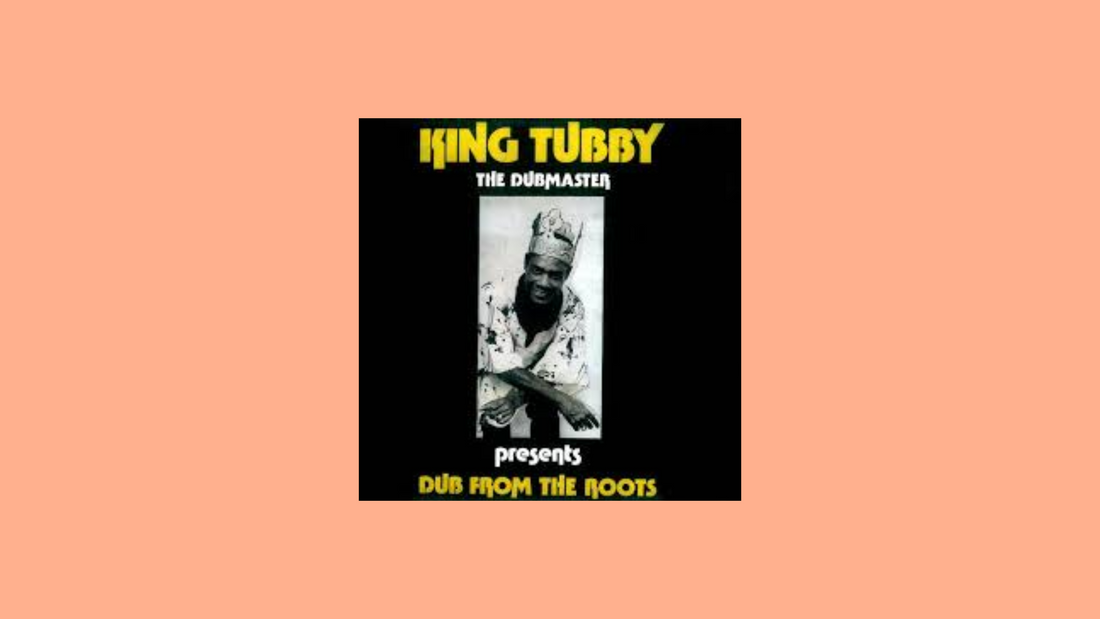
King Tubby – Dub From the Roots (1974)
By Rafi Mercer
A single snare hit rings out, stretched into echo until it seems to bounce across the walls. Then the bass enters — heavy, resonant, elemental. Around it, fragments of horns, guitar stabs, organ chords appear and vanish, each manipulated by faders, filters, and delay. This is not a band playing. This is the sound of the mixing desk itself turned into instrument. With Dub From the Roots (1974), King Tubby defined not just a style of reggae but an entirely new way of thinking about sound.
Osbourne Ruddock, known as King Tubby, began his career as an electronics technician in Kingston, repairing radios and building amplifiers. His genius lay in applying that technical knowledge to music. In the early 1970s he took multitrack recordings from reggae sessions and stripped them down, emphasising bass and drums, dropping instruments in and out, smothering them in echo or reverb. What was once accompaniment became the centre; what was once background became landscape. Dub was born.
Dub From the Roots captures Tubby at his most elemental. It is not an album of songs but of versions — instrumental reimaginings of reggae tracks, transformed into new works entirely. “Dub From the Roots,” the title track, is a statement of intent: a groove so deep it seems geological, with snare hits and guitar fragments flickering like lightning in the distance. “Iyahta” carries a mystical quality, its horns reduced to ghostly wisps, the rhythm section steady as a heartbeat.
On “Invasion,” the bassline rolls like thunder while reverb-soaked percussion ricochets across the mix. “Double Cross” feels sparse, each element isolated, echoing into space, creating a sense of vastness from minimal material. Every track is a study in subtraction: what happens when you remove rather than add, when silence becomes as important as sound.
What makes Tubby’s work revolutionary is not only the sound but the philosophy. He shifted music from performance to process. The studio was no longer a place to capture a song; it was the instrument itself. By manipulating faders and delays, Tubby was performing live in the mix. Each version was unique, ephemeral, a combination of technology, intuition, and timing. It was music made not just of notes but of space.
Culturally, the impact was immense. Dub influenced reggae profoundly, but its echoes extend far wider: into hip-hop, where DJs and producers became central creators; into electronic dance music, where repetition, bass, and remix are foundational; into ambient and experimental sound, where echo and space became compositional tools. Without King Tubby, the language of modern sound would be unrecognisable.
Yet Dub From the Roots is not only historical. It remains deeply listenable, physical, immersive. The bass anchors the body, the echoes alter the room. It is both meditative and energising, minimal and maximal at once. For those new to dub, it is a perfect entry: direct, generous, powerful. There is no need for insider knowledge. The music speaks clearly, its rhythms universal, its space open to all.
For women exploring dub — a culture often framed through sound systems and selectors, spaces coded masculine — Tubby’s music is an invitation. Its intimacy, its use of silence, its balance of force and delicacy show that heavy sound can also be subtle, that bass can nurture as much as it dominates. Dub From the Roots makes room for different ways of listening, different bodies in the space.
On vinyl, the record feels alive. The warmth of analogue bass, the depth of reverb, the faint crackle of the pressing — all merge into the mix. Dub is music built for speakers, for resonance, for physical vibration, and the record repays the fidelity of a good system. But even on modest speakers, its presence is undeniable. The space it creates is as important as the notes themselves.
Nearly fifty years on, Dub From the Roots remains a masterpiece of minimal means and maximal imagination. Tubby took a handful of instruments and turned them into universes. He showed that listening is not only about what is played but about what is withheld, about the way sound inhabits space. He made silence audible.
To put it on today is to enter that space. The room becomes deeper, wider, more alive. You find yourself not only hearing but inhabiting the sound. And in that act, you glimpse why dub has endured: because it is not only music but philosophy, not only rhythm but architecture. King Tubby built those foundations, and Dub From the Roots remains one of the strongest cornerstones.
Rafi Mercer writes about the spaces where music matters. For more stories from Tracks & Tales, subscribe, or click here to read more.














